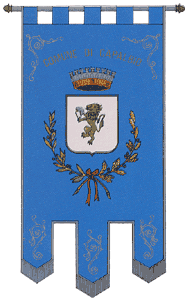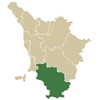|  Inhabitants
in 1991: 4.014 Inhabitants
in 1991: 4.014
 The
municipal territory of Capalbio extends for 187,60 square kilometres in
the coastal hills at the southern extreme of the Toscana Maremma.
Originally incorporated in the territory of Manciano, from 1843 passed
into the community of Orbetello. It was constituted as autonomous municipality
in 1960. Cited for the first time in 1161 in a privilege by Pope
Alessandro III in favour of the Roman Abbey of Sant’Anastasio
at Tre Fontane, Capalbio followed, as did Orbetello, the matter of the
patrimony of the religious body and subsequently of that part of the Aldobrandesca
county that was subject, in the course of the XIII century to the contrasting
political influences of Siena and Orvieto. The
municipal territory of Capalbio extends for 187,60 square kilometres in
the coastal hills at the southern extreme of the Toscana Maremma.
Originally incorporated in the territory of Manciano, from 1843 passed
into the community of Orbetello. It was constituted as autonomous municipality
in 1960. Cited for the first time in 1161 in a privilege by Pope
Alessandro III in favour of the Roman Abbey of Sant’Anastasio
at Tre Fontane, Capalbio followed, as did Orbetello, the matter of the
patrimony of the religious body and subsequently of that part of the Aldobrandesca
county that was subject, in the course of the XIII century to the contrasting
political influences of Siena and Orvieto.
At the beginning of the 1300s the castle was under the dominion of a
local family of Lords (probably descendants of Guido di Capalbio cited
in an act of 1203), who in 1315 allied themselves with Orvieto against
the Aldobrandeschi of Santa Fiora and the Baschi di Montemerano.
The political authority of Orvieto lessened, Capalbio was conceded
to the republic of Siena between 1339 and 1345 by the Aldobrandeschi di
Santa Fiora, but subsequently fell under the dominion of the Orsini.
With the military campaign of 1416 it was conquered definitely by Siena,
so that its history is tied to the successive rise of the republic. During
the resistance the so called “Banda Armata Maremma” (Maremma
Armed Band) was formed at Capalbio, which operated in the area and liberated
the municipality on 13 June 1944.
Places to visit:
The walled village, of Medieval
era still intact
Palazzo Collacchioni, from the early 1900s
was built on the ruins of the Aldobrandesca Fortress.
Oratorio
della Provvidenza fuiori le mura, renaissance church with a small
portico, has an interesting chapel with murals in the interior.
S. Nicola, archpriesthood of XII-XIII century, has murals in
the interior. |
Historical info reproduced upon authorization of Regione Toscana - Dipartimento della Presidenza E Affari Legislativi e Giuridici
Translated by Ann Mountford |